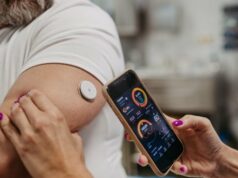
Red light therapy (RLT) is a therapy that uses red low-level wavelengths of light to treat skin issues.
It is most commonly used to treat wrinkles, scars, psoraisis and persistent wounds.
However, in recent years, researchers have started to explore its potential benefits for managing various health conditions including diabetes.
The exploration into red light therapy as a complementary treatment for diabetes is still in its early stages, but the initial findings are promising.
How does red light therapy work?
Red light therapy works by using low-wavelength red light to penetrate the skin to varying depths.
Light is absorbed by mitochondria, the energy-producing centres of cells and has been shown to stimulate cellular processes that can lead to various health benefits.
The primary mechanism of action behind red light therapy’s effectiveness is considered to be its ability to enhance mitochondrial function.
When cells absorb red light wavelengths around 600 to 700 nanometres, it stimulates the mitochondria to produce more adenosine triphosphate, also known as ATP.
ATP is the molecule that fuels cellular activity and increased ATP production can enhance cell regeneration and repair, reduce inflammation, and increase blood circulation.
The scientific name for red light therapy is photobiomodulation.
Red light therapy has gone by many names, including:
- Low level light therapy
- Low power laser therapy
- Photonic stimulation
- Soft laser therapy
Red light therapy uses
Red light therapy has been used for its anti-inflammatory and regenerative properties to support skin health, reduce pain and inflammation.
Beyond dermatological applications, RLT is being researched for its effects on muscle recovery, mental health disorders like depression, and long-term health conditions such as diabetes.
Where can I get red light therapy?
You can buy lamps, masks and panels which provide red light therapy.
These devices contain light emitting diodes (LED) on the device itself which emit red light.
Alternatively, you can choose to visit a red light therapy centre.
Red light therapy and diabetes
Recent studies have indicated promising results for the use of red light therapy in managing blood sugar levels in people with diabetes.
One particular study used a specific wavelength of 670 nm, applied to the skin, which showed a significant reduction in blood glucose levels and moderated peaks after glucose intake.
It is thought that red light at 670 nm enhances the function of mitochondria, leading to an increase in ATP production and more efficient glucose metabolism.
This could potentially reduce blood glucose levels and support overall blood glucose control.
Red light therapy and weight loss
On top of its potential benefits for glucose management, red light therapy is being explored for its role in weight loss.
Studies have shown that exposure to certain wavelengths of red light can cause fat cells to release their lipid content – also known as lipolysis.
Released fat is then metabolised by the body leading to reduced fat mass and improved body composition.
The process is facilitated by the absorption of red light by mitochondria within the fat cells which can increase cellular metabolism and energy expenditure.
Enhanced mitochondrial activity might not only help in reducing the fat layers directly under the skin but also improve the overall metabolic rate which aids in weight management.
While research is promising, red light therapy should complement traditional weight loss methods such as diet and exercise and not replace them.
Further research is needed to fully establish the parameters for safe and effective use such as optimal light wavelengths, exposure duration, and frequency of sessions to achieve the best results.
Combining RLT with a healthy lifestyle could potentially amplify the effects and contribute to more significant and sustainable weight loss outcomes.
How to use red light therapy safely
To ensure safe and effective use of red light therapy:
- Always consult with a healthcare provider before starting any new treatment
- Use RLT according to recommendations from a healthcare professional or qualified therapist
- Keep regular track of blood sugar levels to observe any changes or patterns that arise after starting RLT
Risks and contraindications
Red light therapy (RLT) is generally considered safe and well-tolerated when used appropriately.
However, it is not for everyone.
People with certain medical conditions such as skin cancer or photosensitivity disorders should avoid this treatment.
Direct exposure to the eyes should be avoided during the therapy.
As with any new treatment, individuals considering red light therapy should consult with healthcare team.
!function(f,b,e,v,n,t,s){if(f.fbq)return;n=f.fbq=function(){n.callMethod?n.callMethod.apply(n,arguments):n.queue.push(arguments)};if(!f._fbq)f._fbq=n;n.push=n;n.loaded=!0;n.version=’2.0′;n.queue=[];t=b.createElement(e);t.async=!0;t.src=v;s=b.getElementsByTagName(e)[0];s.parentNode.insertBefore(t,s)}(window,document,’script’,’https://connect.facebook.net/en_US/fbevents.js’);fbq(‘init’, ‘427517474057894’); fbq(‘track’, ‘PageView’);
Source link







